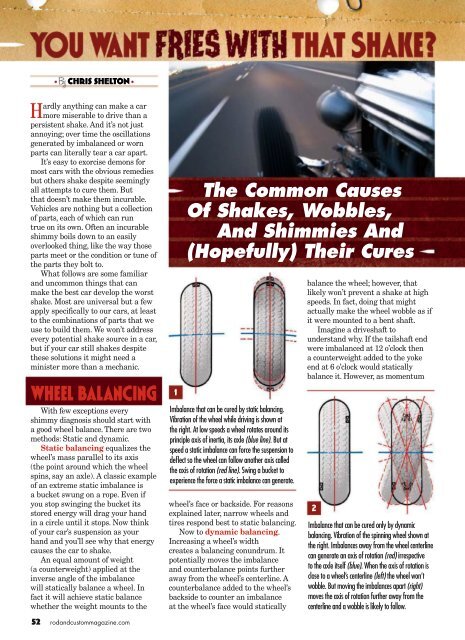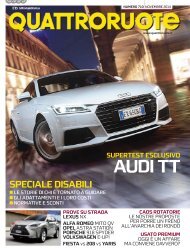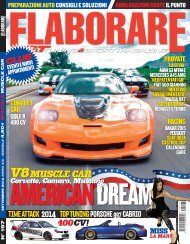Create successful ePaper yourself
Turn your PDF publications into a flip-book with our unique Google optimized e-Paper software.
t By Chris Shelton t<br />
Hardly anything can make a car<br />
more miserable to drive than a<br />
persistent shake. And it’s not just<br />
annoying; over time the oscillations<br />
generated by imbalanced or worn<br />
parts can literally tear a car apart.<br />
It’s easy to exorcise demons for<br />
most cars with the obvious remedies<br />
but others shake despite seemingly<br />
all attempts to cure them. But<br />
that doesn’t make them incurable.<br />
Vehicles are nothing but a collection<br />
of parts, each of which can run<br />
true on its own. Often an incurable<br />
shimmy boils down to an easily<br />
overlooked thing, like the way those<br />
parts meet or the condition or tune of<br />
the parts they bolt to.<br />
What follows are some familiar<br />
and uncommon things that can<br />
make the best car develop the worst<br />
shake. Most are universal but a few<br />
apply specifically to our cars, at least<br />
to the combinations of parts that we<br />
use to build them. We won’t address<br />
every potential shake source in a car,<br />
but if your car still shakes despite<br />
these solutions it might need a<br />
minister more than a mechanic.<br />
WHEEL BALANCING<br />
With few exceptions every<br />
shimmy diagnosis should start with<br />
a good wheel balance. There are two<br />
methods: Static and dynamic.<br />
Static balancing equalizes the<br />
wheel’s mass parallel to its axis<br />
(the point around which the wheel<br />
spins, say an axle). A classic example<br />
of an extreme static imbalance is<br />
a bucket swung on a rope. Even if<br />
you stop swinging the bucket its<br />
stored energy will drag your hand<br />
in a circle until it stops. Now think<br />
of your car’s suspension as your<br />
hand and you’ll see why that energy<br />
causes the car to shake.<br />
An equal amount of weight<br />
(a counterweight) applied at the<br />
inverse angle of the imbalance<br />
will statically balance a wheel. In<br />
fact it will achieve static balance<br />
whether the weight mounts to the<br />
1<br />
The Common Causes<br />
Of Shakes, Wobbles,<br />
And Shimmies And<br />
(Hopefully) Their Cures<br />
Imbalance that can be cured by static balancing.<br />
Vibration of the wheel while driving is shown at<br />
the right. At low speeds a wheel rotates around its<br />
principle axis of inertia, its axle (blue line). But at<br />
speed a static imbalance can force the suspension to<br />
deflect so the wheel can follow another axis called<br />
the axis of rotation (red line). Swing a bucket to<br />
experience the force a static imbalance can generate.<br />
wheel’s face or backside. For reasons<br />
explained later, narrow wheels and<br />
tires respond best to static balancing.<br />
Now to dynamic balancing.<br />
Increasing a wheel’s width<br />
creates a balancing conundrum. It<br />
potentially moves the imbalance<br />
and counterbalance points further<br />
away from the wheel’s centerline. A<br />
counterbalance added to the wheel’s<br />
backside to counter an imbalance<br />
at the wheel’s face would statically<br />
balance the wheel; however, that<br />
likely won’t prevent a shake at high<br />
speeds. In fact, doing that might<br />
actually make the wheel wobble as if<br />
it were mounted to a bent shaft.<br />
Imagine a driveshaft to<br />
understand why. If the tailshaft end<br />
were imbalanced at 12 o’clock then<br />
a counterweight added to the yoke<br />
end at 6 o’clock would statically<br />
balance it. However, as momentum<br />
2<br />
Imbalance that can be cured only by dynamic<br />
balancing. Vibration of the spinning wheel shown at<br />
the right. Imbalances away from the wheel centerline<br />
can generate an axis of rotation (red) irrespective<br />
to the axle itself (blue). When the axis of rotation is<br />
close to a wheel’s centerline (left) the wheel won’t<br />
wobble. But moving the imbalances apart (right)<br />
moves the axis of rotation further away from the<br />
centerline and a wobble is likely to follow.<br />
52 rodandcustommagazine.com

















